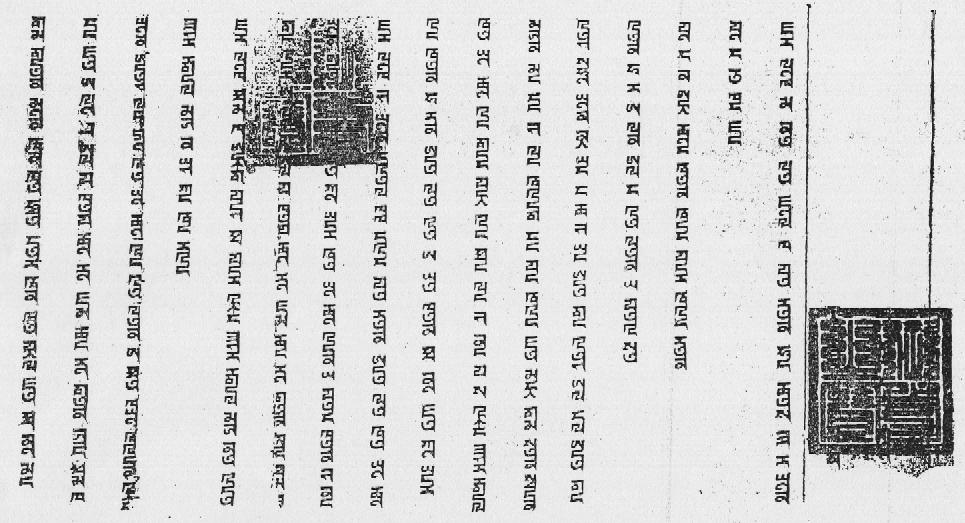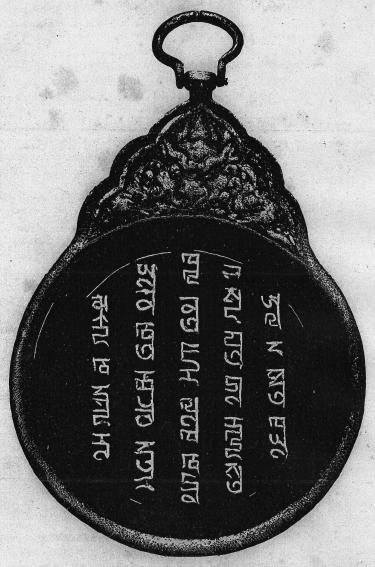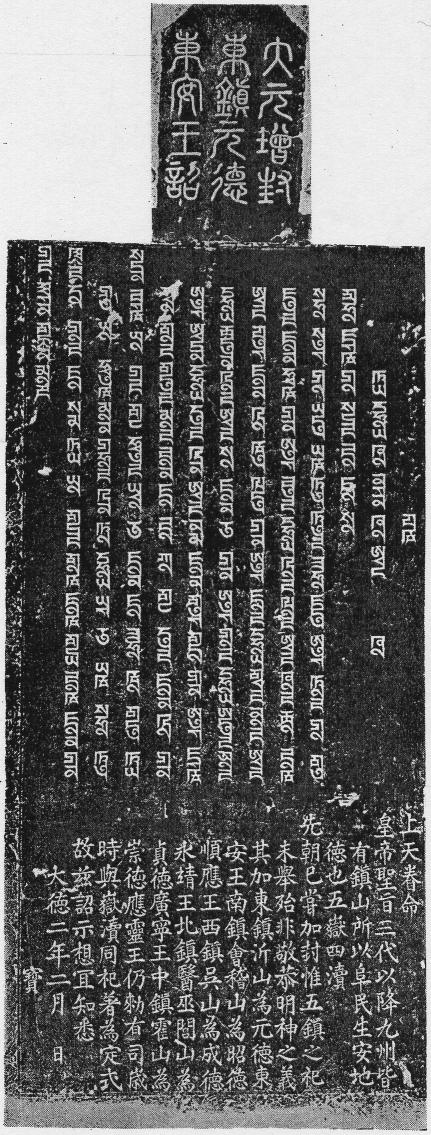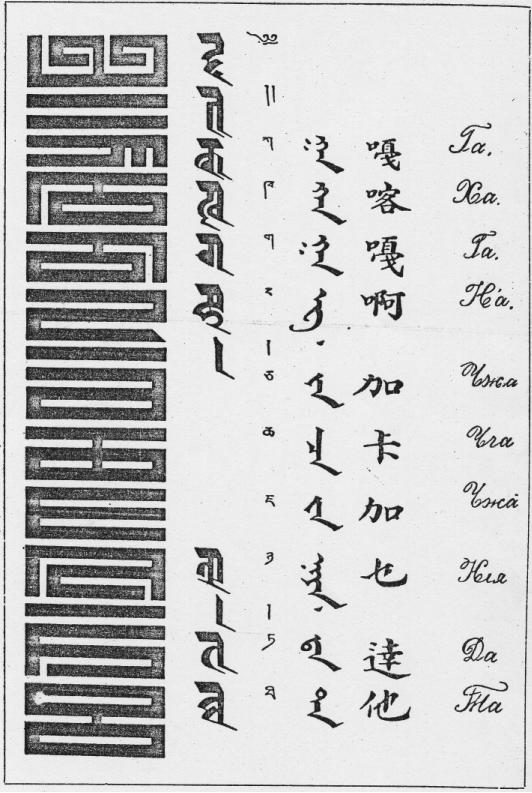
The Phags-pa script is named after its creator, the Tibetan lama known by the title of 'Phags-pa Lama (འཕགས་པ་བླ་མ་) "Reverend Lama" (transliterated as Bāsībā 八思巴 [also 巴思八 or 拔思巴] in Chinese). His given name was Blo-gros rGyal-mtshan བློ་གྲོས་རྒྱལ་མཚན་ (lodoi ǰaltsan ᠯᠣᠳᠣᠢ ᠵᠠᠯᠼᠠᠨ in Mongolian), and he was a member of the mKhon མཁོན་ family of the Sa-sKya ས་སྐྱ་ (pronounced Sakya) clan. He was born in either 1235 (according to Tibetan sources) or 1239 (according to Chinese sources), and he died in 1280.
See Mongolian Exhibition at the Asian Art Museum and JAARS Museum of the Alphabet for some portraits of the 'Phags-pa Lama.
In 1207 envoys from Genghis Khan had arrived unexpectedly in Tibet, and had demanded Tibetan submission. Equally unexpectedly, perhaps, the Tibetan chiefs immediately acquiesced to the demands of the Mongols. Tibet thus avoided the bloodshed meted out to less compliant peoples in East Asia and beyond. Although nominally part of the Mongolian domain, the Mongolians paid little attention to Tibet for the next thirty years.
The nominal rulership of Tibet eventually fell to Godon, second son of Ogodai Khan (himself a son of Genghis Khan), who sent several raiding parties to Tibet in 1239 in order to loot some of the monasteries, with mixed success according to Tibetan sources. Godon eventually decided to summon one of the Tibetan lamas to his court. Thus it was that in 1244 the grand lama of the Sa-sKya momastery, Sakya Pandita ས་སྐྱ་པཎྜི་ཏ་ (1182-1251), set out on a journey to Mongolia as representative of the Tibetans, accompanied by his two young nephews, one being the future 'Phags-pa lama.
Sakya Pandita formally acknowledged Tibetan submission to Mongolian authority, and in return he was appointed Viceroy of Tibet in 1249 (this position was later formalised with the granting of the title "Imperial Preceptor" 帝師 to 'Phags-pa by Kublai Khan after he became emperor, a title which was bestowed on all of 'Phags-pa's successors). However, as a precaution he was detained at the Mongolian court, and had to govern Tibet from a distance (as was also the case for all his successors up until the resurgence of Tibetan nationalism and the dethroning of the Sakya lamas in the 1350s).
In 1253 'Phags-pa succeeded his uncle as Viceroy, and soon after he obtained an audience with the future Kublai Khan (reigned 1260-1294). The prince was so impressed by the young lama that he conferred upon him the title "Supreme Lama, King of the Faith in Three Lands". The future grand Khan and Emperor of China was a powerful figure to win over to Buddhism, and it was his patronage that set the course for the conversion of the Mongols to Tibetan Buddhism.
When Kublai Khan assumed leadership of the Mongol tribes in 1260 he conferred upon 'Phags-pa the additional title of "National Preceptor" (Chinese 國師), and commissioned him to create a new national script to replace the Uighur-based script devised sixty years earlier under the auspices of Genghis Khan. We do not know when 'Phags-pa completed his task, but it was not until nearly ten years later, on the thirteenth day of the second month of the sixth year of the Zhiyuan 至元 reign period (1269), that Emperor Shizu 世祖 (i.e. Kublai Khan) issued an edict mandating the use of the "newly devised" script in all official documents, in parallel with the local script as appropriate. The biography of 'Phags-pa in the History of the Yuan Dynasty (compiled 1369-1370, immediately after the fall of the Yuan dynasty in 1368) gives the following account of the creation of the script :
In the first year of the Zhongtong reign period (1260) the Emperor Shizu ascended to the throne, and he invested the 'Phags-pa lama with a jade seal and the title of "National Preceptor". The Emperor commanded 'Phags-pa to create the New Mongolian Script, and when the letters had been devised 'Phags-pa submitted them to the Emperor. The number of words in the script is only somewhat over a thousand (i.e. 1000+ phonetic syllables representing all possible Chinese ideographs), and the total number of letters is forty-one. The way that the letters are joined together to form words is by means of a "locked vowel" (i.e. the inherant vowel "a"). When two, three or four letters are joined together to form a word, then they constitute a syllable. The important thing is to represent the sound of a word.
In the sixth year of the Zhiyuan reign period (1269) the Phags-pa script was promulgated throughout the empire by imperial command. The edict stated :
It is our opinion that writing is used to represent words, and words are used to record events. This has been the system from ancient times through to the present day. Our nation was founded in the North, and in those times our customs were as yet ancient and uncomplicated, and we had no time to create [our own script]. When we needed to write things down, then we used the Chinese or Uighur scripts in order to represent the language of this court. However, when we look at the Liao and Jin regimes, or other far distant countries, they all have their own scripts. Now the rule of the pen has come to replace the rule of the sword, but we yet lack a means of writing, which really is a failure in this dynasty's system of government. Therefore I expressly commanded the National Preceptor 'Phags-pa to create the New Mongolian Script, which could be used to transcribe all other scripts, in the hope that words may easily be used to express events. Henceforth all offical documents and imperial edicts will be written in the New Mongolian Script, together with a supplementary version of the text written in the local script.
Thereupon the 'Phags-pa lama was elevated to the title of The Great Precious Dharma King, and invested with another jade seal.
中統元年,世祖即位,尊為國師,授以玉印。命制蒙古新字,字成上之。其字 僅千餘,其母凡四十有一。其相關紐而成字者,則有韻關之法;其以二合三合四合 而成字者,則有語韻之法;而大要則以諧聲為宗也。至元六年,詔頒行於天下。詔 曰:
朕惟字以書言,言以紀事,此古今之通制。我國家肇基朔方,俗尚簡古,未 遑制作,凡施用文字,因用漢楷及畏吾字,以達本朝之言。考諸遼、金,以及遐方 諸國,例各有字,今文治浸興,而字書有闕,於一代制度,實為未備。故特命國師 八思巴創為蒙古新字,譯寫一切文字,期於順言達事而已。自今以往,凡有璽書頒 降者,并用蒙古新字,仍各以其國字副之。
遂升號八思巴曰大寶法王,更賜玉印。
The new script is referred to in contemporary Chinese sources as "Mongolian New Script" 蒙古新字, "Mongolian Script" 蒙古字 or "National Script" 國字, in contrast to the old script which was known simply as the "Uighur Script" 畏兀字.
The reason behind the creation of a new script is stated in the edict to be in order to create a national script peculiar to the reigning dynasty (this was two years before Kublai Khan proclaimed the founding of the Yuan 元 dynasty in 1271, and ten years before the overthrowal of the Southern Song dynasty in 1279), in the same way that the recent "barbarian" dynasties of the Khitan and Jurchen peoples (Liao and Jin dynasties respectively) had their own unique writing systems. The Uighur script which had been in use for some seventy years may have been considered unsuitable for use as a national script on two counts :
It is probable that Kublai Khan hoped that the new Phags-pa script would overcome the problems associated with the old Uighur-based script, and be used throughout the Mongolian empire as a single unified script for writing all the disparate languages. Five months after the initial edict, Kublai Khan ordered that schools for the instruction of the new Mongolian National Script be set up throughout the empire, and in the fourth month of the following year (1270) teachers were assigned to these schools.
However, Kublai Khan's dream of a single unified script used throughout his empire by all peoples simply refused to come true. Despite the schools, Mongolian and Chinese officials alike seemed to be reluctant to learn the new script that had been imposed upon them, and its level of use remained low throughout Kublai Khan's reign and after. The resistance to the new script can be gauged from the number of edicts prohibiting the continued use of the Uighur-based script for writing Mongolian in official documents, which obviously had little effect.
The new script was used to a limited extent for writing Mongolian and Chinese during the Yuan dynasty, but almost exclusively in relation to official business, and there are few examples of its usage within the private or personal sphere.
After the collapse of the Yuan dynasty in 1368, the Chinese abandoned the foreign script, whilst the Mongolians competely reverted to the earlier Uighur-based script, which is still in use today. The latest dateable inscriptions with Mongolian text written in the Phags-pa script date to 1351 and 1352 (later Phags-pa inscriptions in Chinese are known).
However the Phags-pa script has continued in use up to the present day to a limited extent as a decorative script in Tibet, mainly for use on seals and architectural inscriptions (see my Phags-pa Script Styles page for details). Tibetan xylographic "script primers" showing model Phags-pa letters are not uncommon, and books on modern Tibetan calligraphy also often show examples of model Phags-pa letters.
The Phags-pa script had from the outset been intended as a "national" script, to be used to represent any and all of the diverse languages that were spoken within the vast Mongolian empire. Although it never replaced any of the existing scripts, it was not entirely unsuccessful in this aim, and Phags-pa inscriptions and texts of various kinds may be found in a number of languages.
Despite the fact that the Phags-pa script had been created primarily to replace the existing Uighur-based script for writing Mongolian, there are actually considerably fewer extant examples of Mongolian usage of the Phags-pa script than of Chinese usage of the script. The majority of surviving examples of Mongolian usage of the script are for official purposes, in particular for the engraving of copies of Imperial edicts or governmental decrees on stone stelae, such as :
In addition to these epigraphic examples, a number of original Yuan dynasty manuscript edicts are preserved at the The Kashag Historical Archives of Tibet at Lhasa, such as the one below :

Source : Minzu Yuwen 民族语文 1996.4 : Back Plate.
Although the majority of monumental inscriptions are copies of official edicts, some non-secular inscriptions do exist, most notably a set of parallel translations of Buddhist texts in six languages (Sanskrit, Tibetan, Mongolian, Uighur, Chinese and Tangut) that are engraved on the "Cloud Platform" 雲台 at Juyong Guan 居庸關 at the Great Wall north-west of Beijing, in commemoration of the construction of a Buddhist edifice in 1345. The Mongolian text is written in the Phags-pa script, and is of particular interest as it uses additional letters for transcribing Sanskrit sounds that are not part of the original set of Phags-pa letters.
Chinese bibliographic sources also refer to a number of Mongolian translations of Chinese books that were printed in the Phags-pa script, including :
Unfortunately no known copies of any of these books survive. However, several fragments from pages of at least two editions of a Mongolian translation of the Subhāṣitaratnanidhi by the Phags-pa Lama's uncle Sakya Pandita (translated in English as A Treasury of Aphoristic Jewels or Sakya Pandita's Treasury of Good Advice, and known in Chinese as 萨迦格言) are known, including one fragment discovered at Dunhuang as recently as 2001.
The other important category of Mongolian Phags-pa inscriptions are Official Passes in the form of small metallic tablets (Chinese 牌子 páizi, Mongolian gerege ᠭᠡᠷᠡᠭᠡ or gerige ᠭᠡᠷᠢᠭᠡ), of which quite a few examples are still extant.

Source : Лекціи по исторіи монгольской литературы Plate opposite page 153.
The most westerly example of a text written in the Phags-pa script is a birchbark manuscript with a fragment of a single line of Phags-pa writing, reading ral baq shi cha (baq shi = Mongolian baɣši ᠪᠠᠭᠱᠢ "teacher, scholar" ?), that was found in a burial on the banks of the Volga during the 1930s. This dates to the period of the Golden Horde Khanate (1240-1502).
Although the Phags-pa script had been devised primarily for writing Mongolian, in fact the majority of extant Phags-pa texts are actually written in Chinese. The biggest class of Chinese Phags-pa texts are monumental inscriptions, mostly comprising governmental edicts and decrees, written in Chinese with Phags-pa transliteration. Several dozen such examples survive, dating from as early as 1269 up to 1363.

Source : Basibazi yu Yuandai Hanyu 八思巴字與元代漢語 Plate 29.
The official nature of the Phags-pa script can be seen from the fact that it was used extensively (but not exclusively) on both coins and banknotes issued during the Yuan dynasty, including :
Many official seals dating from the Yuan dynasty and the rump Northern Yuan court (1368-1402) also have Phags-pa inscriptions, almost all transcribing Chinese, and engraved with a pseudo-archaic "seal script" form of the Phags-pa letters.
Although the Phags-pa script tends to be restricted to public or official contexts, there are some examples of its usage in a private context. For example the Phags-pa script is found on a number of Yuan dynasty Christian tombstones from the famous port city of Quanzhou 泉州 in Fujian province (see Christian Tombstones of Zayton for some examples).
Only one printed Chinese text written in the Phags-pa script is known to exist. This is the elementary text The Hundred Surnames (百家姓 bǎijiāxìng), that is included within Yuan and early Ming editions of the popular encyclopaedia Shìlín Guǎngjì 事林廣記.
One very important contemporary resource is a rhyming dictionary of Chinese with Phags-pa script spellings, entitled Měnggǔ Zìyùn 蒙古字韻, that was edited by Zhu Zongwen 朱宗文 in 1308. This work gives lists of Chinese ideographs with the same pronunciation (excluding tonal differences, which are not represented in the Phags-pa script), together with their pronunciation as spelled out in Phags-pa letters.
After the fall of the Yuan dynasty, the Phags-pa script immediately fell out of use among the Chinese, and the only examples of its practical use during the Ming dynasty are fake "Yuan" porcelain bowls with the date mark written in the Phags-pa script (ji jing neen ji -i for 至正年製 "Made during the Zhizheng [1341-1368] period" in very badly formed letters), some of which are archaeologically dateable to the Zhengde 正德 period (1506-1521) (Lü Chenglong 2001).
Probably because the Phags-pa script was so similar to the Tibetan script, there was never any real reason to use the Phags-pa script to write Tibetan in preference of the native Tibetan script, and so there are few examples of Tibetan texts written using the Phags-pa script.
However, the Phags-pa script was adapted by the Tibetans for use as a decorative script, mainly for engraving seals, inscribing the title on the covers of traditional pecha style books, and for engraving inscrptions on architectural features such as temple columns. A well-known example of the recent use of the Phags-pa text by Tibetans is the Gold Seal of 13th Dalai Lama, made in 1909, which has inscriptions in the Tibetan and Phags-pa scripts.
The stylised, angular Tibetan Style form of Phags-pa letters are graphically quite different from the standard Phags-pa letters seen in Yuan dynasty monumental inscriptions, as can be seen by the following example of a woodblock edition of a primer for the Phags-pa and Lantsa scripts that was obtained by a Buriat Cossack officer, Tsokto Garmeyevich Badmazhapov, in 1903 (similar "script primers" with model Phags-pa letters are not uncommon, as for example this woodblock print).

Source : The Mongolian Monuments in ḤP'AGS-PA Script page 16.
The Phags-pa script was also used for writing Old Uighur and other Turkic languages within the Mongolian empire. However, very few examples of Turkic Phags-pa usage have survived. The only ones that I know of are Uighur signatures on seals that have been stamped on documents written using the Uighur script (see for example Uigur Administrative Orders Bearing "Qutlugh-Seals").
However, in his work on calligraphy, Shūshǐ Huìyào 書史會要, the late Yuan / early Ming author Tao Zongyi 陶宗儀 does use Phags-pa letters to describe the pronunciation of the letters of the Uighur script, which is a good indication of how Old Uighur was represented using the Phags-pa script. See my Old Uighur Script page for further details.
It is quite probable that Persian (known as huíhuí 回回 in contemporary Chinese sources) was also written in the Phags-pa script, although there are no known extant examples of Persian Phags-pa texts. Nevertheless, one of the forty-one original Phags-pa letters (GGA) is not used in writing Chinese, Mongolian or Old Uighur, and may perhaps have represented a glottal stop for use in writing Persian (i.e. the letter 'ayn ع).
Date: 2006-12-21
Forty-One Letters | Old Uighur Script | Baijiaxing Mengguwen | Menggu Ziyun